Pavlovsk lemon care
Lemon is an evergreen tree that bears fruit all year round. To grow it at home, you need to provide appropriate growing conditions and choose the right variety. One of the varieties of houseplant is Pavlovsky lemon. It is characterized by its compact size and high vitamin content in the fruit.
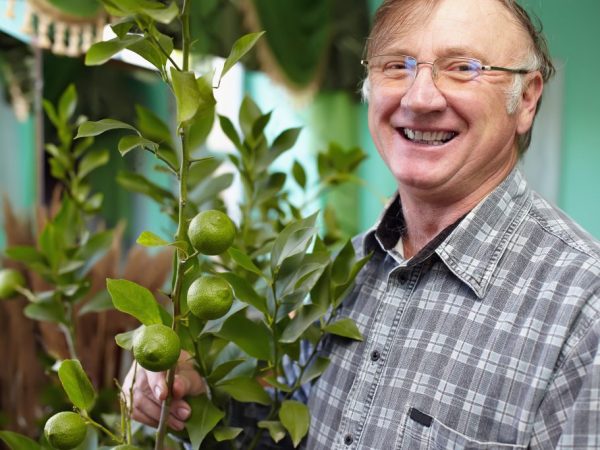
Pavlovsk lemon care
Lemon characteristic
The citrus tree variety has a hundred-year history. The lemon was brought to Pavlovo from Turkey back in 1860. In 1953, a strong point was created for the study and reproduction of the Pavlovo lemon.
Description of the tree
According to the description, Pavlovsky lemon reaches 1-1.5 m in height. The plant grows in a bush with branches down, consists of 2-4 trunks. The crown is rounded, up to 1 m in diameter. It has a gray-green color and longitudinal cracks. Young shoots have a bright green crown.
The branches of the bush have thorns up to 2 cm long. They are pointed at the ends, and widened at the base. There are also hybrids without thorns. Shoots grow up to 70 cm per year.
The leaves of the Pavlovsky lemon variety are large, up to 15 cm in length, in width - 6-8 cm. The shape of the leaf is different:
- oval;
- wide oval;
- broad lanceolate;
- oval-oblong.
The base of the leaf blade is wedge-shaped, with a slight pointed upward. The surface of the leaves is glossy. They are deep green in color, rich in essential oils and a lot of vitamins. Leaves live up to 3 years, then fall off.
Description of colors
Indoor evergreen blooms throughout the year. This happens most often in March or September. On one bush there can be both fruits and young ovaries with buds. Inflorescences have 3-8 flowers. Of all the blossoming flowers, only 17% of the ovaries are preserved on the plant.
The culture is self-pollinating. Cross-pollination is done artificially. Large bisexual flowers 2-3 cm in diameter. They are white in color with yellow stamens. So that the bush does not weaken and disappear, the flowers are cut off in the first 2 years.
Description of fruits
The plant begins to bear fruit at an early age: 3 years after the rooting of the cuttings. At home, the growth and maturation process takes about a year. Fruits up to 10 cm long, bright yellow, with a skin of 5 mm. The surface is smooth, the flesh is sweet and sour.
One bush has about 8-10 fruits. They have a citrus scent and antibacterial properties. There are 5-7 seeds in one fruit. If fruits are not harvested on time, they continue to grow, turn green and lose their flavor. They stay on a tree for up to a year.
Growing lemon
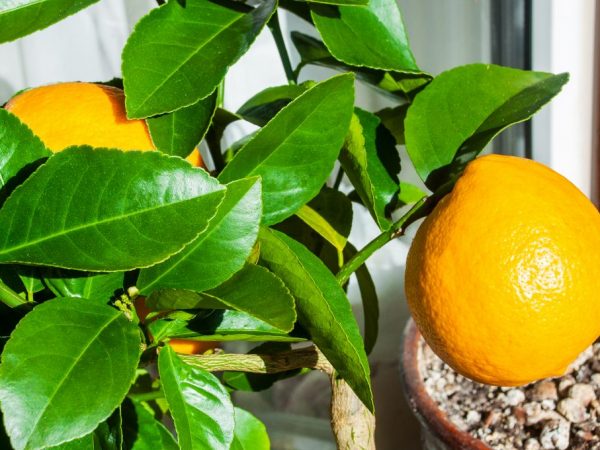
Do not place the plant on the south side
Pavlovsky lemon at home is placed on windowsills from the east or south-east side. On the southern windows, he often gets burns from the sun's rays.
For good growth, choose a soil that includes the following components:
- river sand;
- sod land;
- leaf distillation;
- manure.
A drainage with a piece of brick with a layer of up to 2 cm is lowered to the bottom of the container. It is also replaced with charcoal. River sand and prepared substrate are poured on top with a layer of 1.5 cm. A seedling of Pavlovsky lemon is planted in a container 5 cm deep. After that, it is watered with warm water and placed in diffused light.
Planting capacity
Growing Pavlovsky lemon at home is carried out in pots made of different materials:
- ceramics;
- wood;
- plastics.
Each type has its own pros and cons. It is important to ensure good drainage in any pot and treat it before planting. If old wooden pots are chosen for planting, they are treated with lye (ash infusion).
In order for an indoor adult plant to bear fruit well, use wooden conical tubs. By size, containers are selected in which the diameter of the upper part is equal to the height, and the bottom is moderately narrow. When transplanting a plant with roots sticking out from under the soil, use a flowerpot 2-3 cm larger in diameter than the current one.
Reproduction
Pavlovsky lemon is propagated by:
- seeds;
- cuttings,
- budding;
- air layering.
Propagating the plant by layering, old bushes of culture with tasteless fruits are used. To do this, an incision is made on a branch, cuttings are grafted into the cut site. Only the bark is cut without damaging the wood. After the seedling is inserted into the branch, they are tied with a washcloth, electrical tape or raffia.
Citrus crops are inoculated mainly with the kidneys. Cuttings for grafting are harvested from a biennial plant on branches of the 5th order of branching. They are stored in moss or wet sand.
The cuttings develop rapidly, and the first harvest ripens in 1.5 years. Budding is done during the period of active sap flow in cuttings: from March to June.
Seeds
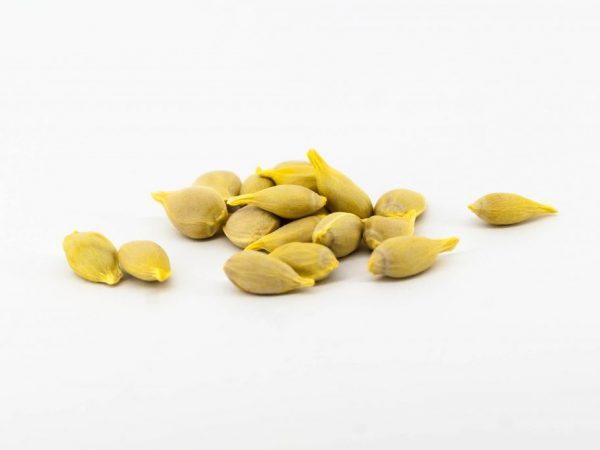
Seeds are planted immediately after being removed from the fruit.
The seeds are sown immediately after being removed from the fruit, otherwise they will not sprout. They are planted in a small container 23 cm deep. In order for the seeds to germinate, the room temperature is kept at about 25 ° C. The seedling is watered with soft non-chlorinated water.
If using hard water, add 1 tsp to the bucket. sulfuric acid or 1 tbsp. l. potash. With this care, the seeds germinate in 14-20 days. Seed plants begin to bloom 10 years after planting. They also rarely produce crops, so they are grafted. Grafted Pavlovsky lemons begin to bear fruit in 3-4 years.
Propagation by cuttings
Cuttings are the most popular and reliable breeding method. The plant begins to bear fruit at the 3rd year of life. Cuttings measuring 10 cm in length and 0.5 in diameter are cut from a healthy plant in March or April. The cut is made at an angle from the top of the kidney and from the bottom.
The stalk should have about 5 leaves, from which the lower ones are removed. Before planting, the cut is treated with charcoal or a solution of heteroauxin with the calculation of 0.1 g per 1 liter of water. The container for planting is chosen from plastic or wood. Drainage is placed at the bottom:
- pebbles;
- broken brick;
- expanded clay.
The substrate is prepared from turf, sand and peat, or a special mixture is purchased in the store. The seedling is watered, and after rooting, it is transplanted into a larger container. You can also cover the cuttings with a jar or plastic wrap to maintain an appropriate temperature of 22 ° C. Covering is kept for 2 months.
Plant care
For quick good growth and development of Pavlovsky lemon, several care rules are followed.
| room | Care conditions | Description |
| 1 | Shine | Citrus fruits are plants that prefer short daylight hours. Long daylight hours produce good growth but poor harvest. Plants on the southern windows are shaded with a cloth so that direct sunlight does not harm. Lemons cannot be taken out into the street: they can die from a sharp change in the light regime. Diffused light is the best option for both fruiting and growth. |
| 2 | Temperature | Indoors, the optimum temperature for growing a tree is from 18 ° C. In winter, the thermometer should show 15 ° C. |
| 3 | Humidity | Heat-loving wood is demanding on air humidity. In addition to watering, the humidity indicator in the room should be at the level of 60-70%. From excessive dryness, the plant sheds leaves and flowers. A container with water is placed near the flowerpot to normalize the moisture level if the air in the apartment is dry. |
Home care for Pavlovsky lemon requires appropriate feeding and watering.
Watering
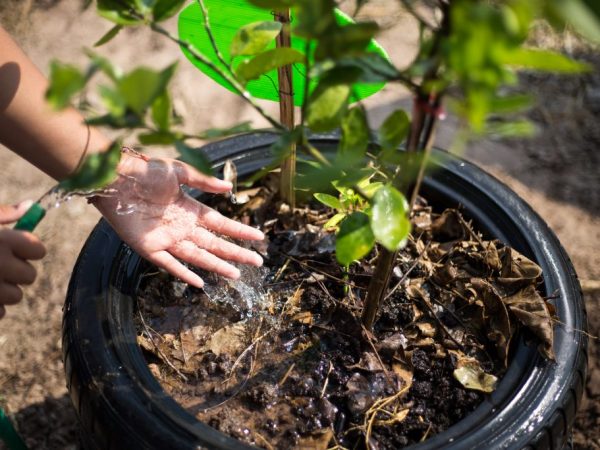
It is necessary to water the tree with warm water.
When watering, they adhere to several principles:
- young seedlings are watered more often and more abundantly than an adult tree;
- watering is moderate in winter, and abundant in summer, the leaves are sprayed;
- trees in ceramic containers are watered more often than in wooden or plastic ones: the soil dries faster in them;
- watering is carried out in the morning or late in the evening.
To determine the moisture content of the soil, a finger is lowered into it 2 cm.
If the earth has stuck to it, watering is not needed. Also, by tapping on the container, the need for watering is determined. If the sound is voiced when tapped, water it; if it is dull, watering is not needed.
In summer and spring, Pavlovsky lemon is watered 1-2 times every 7 days. In winter - 2 times every 25 days. The water temperature should be within 30 ° C. Watering and spraying is carried out only with water at room temperature, settled or boiled.
It is impossible to water with cold, chlorinated water with lime. Water with a high salt content is harmful to crops by forming a crust on the soil. It does not allow all the important trace elements to reach the indoor tree, as a result it begins to rot. Also, experts recommend using rainwater or liquid from a river or lake.
Fertilizer
When a plant sheds its leaves or they begin to turn yellow, this indicates a scarce supply of nutrients in the earth.
The tree needs to be fertilized. From mid-winter to early autumn, the Pavlovsky variety is fed with mineral fertilizers. For this, ammonium nitrate is suitable with the calculation of 3 g per 1 liter of water.
When the tree turns 2 years old, it is fertilized with a phosphorus-potassium solution: 4 g of potassium salt, 3 g of superphosphate are mixed with 1 liter of water. The mixture is added 2 times a month. Before each feeding, the flowerpot is watered.
From organics, bird droppings are used for feeding. For this, 1 kg of manure is mixed with 20 liters of water. In winter and summer, citrus fruits are fertilized:
- ash - 1 tsp. for 1 liter of water;
- boric acid - 10 g per 2 liters of water;
- aspirin - 2 tablets per 5 liters of water.
Transplanting and pruning lemon
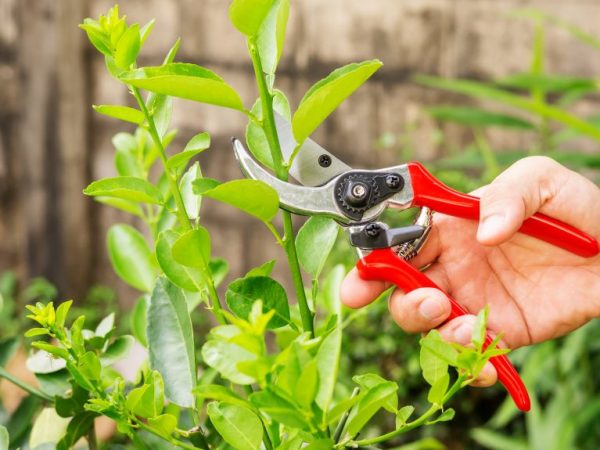
Pruning does not harm the plant
Once every 2 years, the Pavlovsky variety is transplanted into a new pot. This is done when the roots take up all the space in the container. During transplantation, the soil is carefully removed from the root system, rotted and diseased roots are cut off.
When transplanting into a new flowerpot, drainage and a prepared substrate from:
- turf;
- leafy land;
- humus;
- peat;
- river sand.
After transplanting, the plant is watered abundantly and placed in a permanent warm place for 14 days.
A beautiful aesthetic appearance is given to the plant with the help of pruning. In a young plant, in early spring, new shoots are pinched at a level of 5 cm from the edge. An adult representative is pruned according to his taste: pruning does not do any harm to the lemon of this variety.
Pests
Common insects that harm a plant include:
- Shield. This insect is dark brown in color. It sticks to leaves and shoots.
- Aphids. These are greenish-yellow or black inactive pests 1-5 mm in size. They settle on leaves, flowers, buds, suck the juice out of them. Aphids stick around the leaves in whole colonies and multiply rapidly.
- Spider mite. It starts up in a dry room at high temperatures. Appears on the underside of a leaf, entwining it with a thin web and sucking out the juice. Damaged leaves turn pale and fall off.
- Whitefly. It is 2-3 mm in size and settles on the underside of the leaves. White moth with powdery pollen. The plant is harmed by the greenish whitefly larvae. They feed on sap, releasing a sweet substance that leads to the disease of the culture.
- Earthworms. They do not harm the roots, but due to the amount they make it difficult to drain excess water. The soil turns sour and the lemon dies.
- Thrips. They are detected by silvery streaks on the leaves, which discolor and fall off.
- Spider mite. It is a small black insect. A cobweb appears on the leaves.
Leaves due to pests curl or bend, discolor and become thin. The flowers are deformed, the buds fall off.
Lemon disease
Most often indoor citrus trees get sick:
- gommosis;
- leaf spot;
- anthracnose;
- powdery mildew.
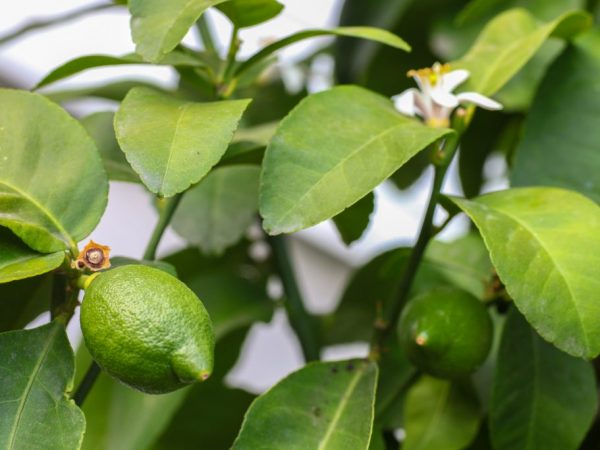
Examine the plant regularly for signs of disease
The result of the appearance of a scale insect on the culture is a sooty fungus. It disrupts photosynthesis, as a result the bush dries up. Abundant release of resin is a sign of gommosis. The reasons may be:
- pests;
- improper feeding;
- lack of drainage;
- non-disinfected instruments during transplantation.
The appearance on the leaves of an indoor flower of dark, wet spots of an irregular shape is a sign of spotting. If it is neglected, symptoms appear on the stems, as a result, the tree dies. Anthracnose - dark brown spots that capture the tips of the leaves. The disease develops with high humidity and a lack of phosphorus with potassium.
Fight disease
Gommosis treatment is carried out in several stages:
- get rid of pests;
- reduce the amount of fertilizer and watering;
- cut out the affected areas;
- treated with Bordeaux solution;
- cover with pitch;
- disinfected with copper sulfate.
Anthracnose and mottling are treated by cutting off decaying leaves and branches and treating them with fungicides.
Viral diseases are not cured. Plants adjacent to the affected plants are quarantined, and the diseased are destroyed.
The remedy "Fitosporin-M" is also used against diseases. It is not addictive and has a high effectiveness in treatment.
Pest control
Against scale insects, spider mites and thrips, all stems and leaves are thoroughly washed with a solution:
- chlorophos - 60 g per 10 liters of water;
- anabazine sulfate - 30 g per 10 l of water and 45 g of soap;
- karbofos - 35 g per 10 liters of water;
- soap-kerosene emulsion - 10 g of kerosene, 5 g of soap per 1 liter of water.
To combat aphids and whiteflies, tinctures of garlic or hot red pepper are used. Plants infected with aphids, scale insects and thrips are washed 3-4 times every 7-10 days. Scented geranium is also a repellent against aphids.
To combat spider mites and scabbards, tinctures of yarrow, potato tops, horse sorrel and dandelion are also used.
Against earthworms, the pot is immersed in water at a temperature of 40 ° C-50 ° C. When the worms come out, they are collected. The soil is sprayed with pink potassium permanganate or mustard solution with the calculation of 1 tsp. for 1 liter of water.
For the prevention and control of whitefly, drugs are used:
- Tanrek;
- Inta-vir;
- "Alatar".
An effective remedy against it is shag tincture. To do this, 40 g of makhorka is poured into 1 liter of hot water and insisted for 2 days. The solution is filtered and 40 g of soap is added to it.
Conclusion
The process of caring for Pavlovsky lemon or tangerine is laborious, but all the work will be rewarded when a tree with bright juicy fruits grows at home. Lemon, as a southern plant, places high demands on light, heat, nutrition and moisture.


